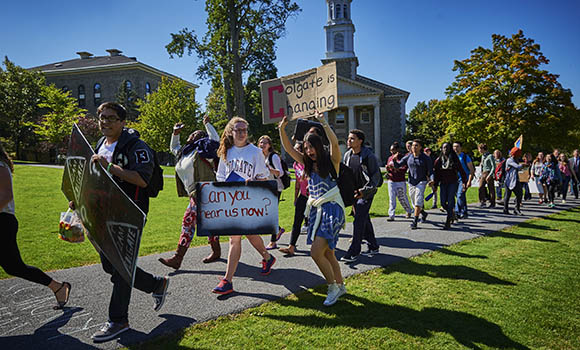
Students celebrate the conclusion of a 100-hour demonstration Friday, September 26. (Photo by Andy Daddio)
ŌĆ£Can you hear us nowŌĆØ gave way to ŌĆ£We love ░─├┼┴∙║Ž▓╩, Go ŌĆśGate, No HateŌĆØ as about 400 students, faculty, and staff marched together from the Hurwitz Admission Center at James B. ░─├┼┴∙║Ž▓╩ Hall to Memorial Chapel on the Academic Quad.
The euphoric and historic ceremony marked the end of a peaceful, that was initiated by students on Monday, Sept. 22, in order to create a culture of greater inclusivity on campus.
Amidst the chanting came a fitting sound: the Chapel bell tolled a ceremonial 13 times.
[youtube http://youtu.be/ijWxugUQV_o]
ŌĆ£We ring the bells to mark a passage, a victory, or a celebratory moment,ŌĆØ said Deacon Mark Shiner, university chaplain, who invited Cyierra Roldan ŌĆÖ16 to do the honors. ŌĆ£Hopefully today is all three.ŌĆØ
Hope is apropos and so will be hard work, as the process of creating a culture of inclusivity is difficult and ongoing. ŌĆ£,ŌĆØ a new website dedicated to the cause, features a 21-point road map that will be followed closely for months and years to come. The document was developed over many hours of conversation between students representing the ░─├┼┴∙║Ž▓╩ Association of Critical Collegians (ACC), and ░─├┼┴∙║Ž▓╩ President , , dean of the college, and , provost and dean of the faculty.
ŌĆ£We all have learned and grown over the past week,ŌĆØ said President Herbst, ŌĆ£and moving forward we are committed to working on all of the issues and action items that have been raised, as well as others that were not formally articulated.ŌĆØ
Nelson, who has experienced other student demonstrations during her career, said, ŌĆ£Today is an important day. IŌĆÖm grateful to our students for raising up their voices and challenging us in all the right ways.ŌĆØ
Kori Strother ŌĆÖ15 spoke today on the steps of James B. ░─├┼┴∙║Ž▓╩ Hall. ŌĆ£I am so proud of everyone,ŌĆØ she said. We walk up the hill with our heads held high. I will never forget this.ŌĆØ
The student movement offered a teaching and learning moment. ŌĆ£Our students have been remarkable in their thoughtfulness and organization,ŌĆØ said Hicks. ŌĆ£It was clear they were putting into practice lessons learned from coursework. ░─├┼┴∙║Ž▓╩ will be stronger for it.ŌĆØ
Susan Thomson, assistant professor of peace and conflict studies, brought her International Human Rights, Law and Advocacy students to meet on the patio of the James B. ░─├┼┴∙║Ž▓╩ building.
Thomson said, ŌĆ£A key theme of our course is the formal (government imposed) and informal (happening in society) policies and practices of exclusion that make mass political violence part of the Rwandan landscape. We then talked about the informal practices and micro-aggressions of racism and privilege that are currently happening on campus.ŌĆØ
Thomson said the conversation opened many studentsŌĆÖ eyes to the extent to which some members of the ░─├┼┴∙║Ž▓╩ community are being shunned or excluded. ŌĆ£Now that they know, some said they will stand up and speak out (i.e., be an ally) when they see injustice on campus.ŌĆØ
[youtube http://youtu.be/ltRGZAsqqqo]
